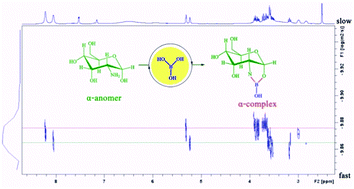Probing the interactions of GlcNH2 with boric acid via NMR spectroscopy†
Abstract
The essential role of boronic esters in controlling both the direction and selectivity of chemical reactions as well as their significant function in catalytic activity have been demonstrated for industrially important processes. The specific interaction analyses of the monosaccharide GlcNH2 with boric acid are of interest since monosaccharides serve as model systems for the more sophisticated carbohydrate molecules. The interaction of GlcNH2 with boric acid was systematically investigated by numerous NMR techniques. A 1 : 1 chelate boron complex coordinated at the cis-1,2 position of GlcNH2 was identified as the major species in DMSO-d6 solution via1H and 13C INEPT DOSY NMR spectroscopy. This specific boron nitrogen coordination mechanism was further supported by the 1H–15N HSQC spectra. Variations in the spin–lattice relaxation times (T1) of the 13C1 nucleus also provided quantitative data regarding this non-covalent interactions. This is an application of 1H, 13C INEPT DOSY, 1H–15N HSQC, and relaxation methods to study such aggregations in solutions. These methods have potential applications in the characterization of reactive intermediates in biomass conversions.



 Please wait while we load your content...
Please wait while we load your content...